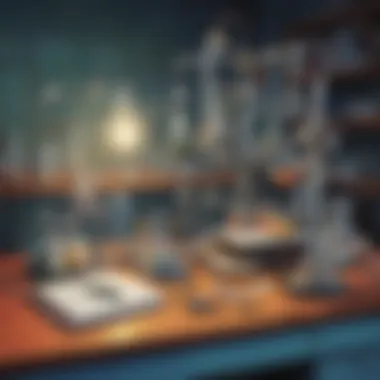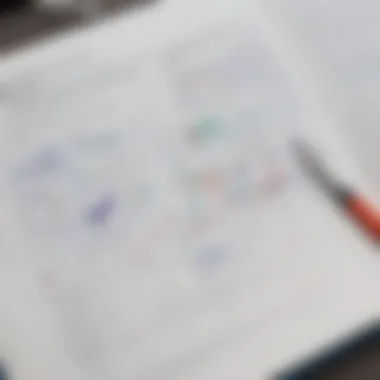Unleashing the Power of Science Fair Projects: A Complete Guide to the Scientific Method


Science Fun Facts
Science fair projects are like exploring uncharted territories -- embarking on thrilling adventures where you get to unravel mysteries and discover new knowledge. Did you know that the scientific method, the backbone of all experiments, was first described by an Arab scholar named Ibn al-Haytham in the 11th century? Imagine the impact of his work on modern science!
Discover the Wonders of Science
As young Science Enthusiasts delve into the realm of science fair projects, they are introduced to a plethora of fascinating scientific concepts. From understanding the basic principles of physics to investigating the intricacies of chemical reactions, every experiment is a journey of discovery. Interactive learning tools such as educational videos and animations further enhance the learning experience, making complex theories easily understandable.
Science Quiz Time
Testing knowledge is the ultimate thrill for Science Explorers! Interactive quizzes not only gauge understanding but also promote critical thinking and problem-solving skills. Multiple choice questions challenge young minds to think analytically, while brain teasers and puzzles add an element of fun to the learning process. Through gamification, learning becomes an exciting adventure where every question unlocks a new realm of knowledge.
Science Experiment Showcase
Get ready to dive into a world of hands-on exploration with the Science Experiment Showcase. Engaging experiments, complete with step-by-step instructions and a detailed materials list, make conducting science fair projects accessible and exciting. Safety tips and precautions ensure that every budding scientist can experiment with confidence, fostering a love for inquiry and exploration.
Introduction
Science fair projects serve as a gateway to ignite young minds with the wonders of scientific exploration. In this article, we embark on a captivating journey delving into the realm of experimental inquiry. Understanding the scientific method is crucial for budding scientists to conduct systematic investigations and unravel the mysteries of the natural world. Through hypothesis formulation, experimental design, and data analysis, participants will hone their critical thinking skills and cultivate a passion for learning through hands-on experiences.
Exploring the scientific method in science fair projects offers a structured approach to problem-solving and inquiry. It encourages participants to pose questions, make observations, and construct logical explanations based on evidence. This foundational knowledge not only fosters intellectual curiosity but also lays the groundwork for developing essential skills in experimental design and analysis. The ability to apply a systematic and evidence-based approach not only enhances scientific literacy but also cultivates a mindset of inquiry and exploration among young learners.
The significance of understanding the scientific method extends beyond the confines of academia. By engaging in science fair projects, participants develop transferable skills such as critical thinking, data interpretation, and communication. These skills are invaluable in navigating the complexities of the modern world and preparing young minds for future academic and professional endeavors. Science fair projects provide a platform for young minds to demonstrate creativity, ingenuity, and analytical thinking, fostering a culture of innovation and discovery among future generations.
Through this comprehensive guide, young Science Buddies will unlock the potential of their projects by embracing the systematic and evidence-based approach of the scientific method. From formulating hypotheses to analyzing data, participants will embark on a transformative journey of learning, discovery, and personal growth, laying the foundation for a lifelong appreciation of science and inquiry.
Understanding the Scientific Method
Understanding the Scientific Method is fundamental in the world of science fair projects. It serves as a structured approach to conducting experiments and uncovering valuable insights. By comprehending the scientific method, young Science Buddies can learn how to formulate hypotheses, design experiments, collect data, and draw meaningful conclusions. This knowledge empowers them to engage in scientific inquiry effectively. Understanding the Scientific Method provides a framework for inquisitive minds to explore the world around them systematically and analytically.


Overview of the Scientific Method
The Scientific Method is a systematic approach used by scientists to investigate natural phenomena. It involves a series of steps that guide the process of inquiry and discovery. These steps typically include making observations, asking questions, forming hypotheses, conducting experiments, analyzing data, and drawing conclusions. The Scientific Method is characterized by its emphasis on empirical evidence, logical reasoning, and reproducibility.
Key Steps in the Scientific Method
- Observation and Question Formulation: Observation involves gathering information through the senses or instruments, while Question Formulation refines these observations into specific inquiries. This step is crucial as it lays the foundation for the entire scientific investigation, guiding the direction of research.
- Hypothesis Development: Hypothesis Development entails formulating a testable explanation for a scientific phenomenon based on existing knowledge or theories. It allows young scientists to make predictions and design experiments to test their ideas.
- Experiment Design: Experiment Design involves planning and executing procedures to test the hypothesis effectively. This step requires careful consideration of variables, controls, materials, and methods to ensure the reliability and validity of the results.
- Data Collection: Data Collection involves gathering information and measurements during the experiment. Accurate data collection is essential for drawing meaningful conclusions and supporting or refuting the hypothesis.
- Analysis and Conclusion: Analysis and Conclusion require interpreting the data collected to determine trends, relationships, and potential explanations. Drawing conclusions involves reflecting on the results and evaluating whether they support the initial hypothesis.
Importance of Following a Systematic Approach
Following a systematic approach in scientific inquiry is essential for ensuring the rigor and reliability of the results. By adhering to a structured process like the Scientific Method, young researchers can avoid bias, errors, and arbitrary conclusions. A systematic approach fosters discipline, critical thinking, and attention to detail, training Science Buddies to conduct thorough and credible experiments.
Choosing a Science Fair Project
In the realm of science fair projects, the process of selecting a project to work on is crucial. The choice of a science fair project lays the foundation for the entire scientific exploration and learning experience that follows. By engaging in the decision-making process of selecting a project, young Science Buddies embark on a journey of self-discovery, intellectual curiosity, and critical thinking. The selection of a project is significant as it allows participants to align with their interests, explore their curiosities, and challenge themselves to delve deeper into the world of science.
Identifying Your Interests and Curiosities
Identifying your interests and curiosities is the initial step in choosing a science fair project. This process involves introspection and reflection to determine what fascinates and captivates your attention. By pinpointing subjects or topics that spark curiosity, Science Buddies set the stage for meaningful and engaging project exploration. Understanding one's interests helps in sustaining motivation throughout the project, making the scientific journey more enjoyable and rewarding. It enables participants to connect with the project on a personal level, fostering a deeper sense of connection and engagement.
Researching Project Ideas
Researching project ideas is a fundamental aspect of selecting a science fair project. This phase involves exploring a myriad of topics, concepts, and scientific domains to discover potential project avenues. Science Buddies delve into resources such as books, online databases, scientific journals, and educational websites to gather inspiration and insights. Researching project ideas broadens participants' horizons, exposes them to new concepts, and encourages out-of-the-box thinking. It aids in refining project goals, defining research questions, and conceptualizing the project's overall scope and objectives.
Considering Feasibility and Available Resources
Considering feasibility and available resources is a critical factor in choosing a science fair project. Participants assess the practicality and viability of project ideas based on various criteria, such as time constraints, access to materials, and complexity of experiments. By evaluating feasibility, Science Buddies ensure that their chosen projects are achievable within the designated time frame and resources. This process involves strategic planning, resource allocation, and risk assessment to mitigate challenges and optimize the project's success potential.
Crafting a Hypothesis
Crafting a hypothesis holds a crucial position in the realm of science fair projects as it is the initial step that sets the groundwork for the entire experiment. When crafting a hypothesis, a young scientist formulates a prediction regarding the outcome of the experiment based on existing knowledge or observations. This prediction acts as a guide throughout the experiment, helping to structure the research and conclusions. By crafting a clear and concise hypothesis, the young Science Buddy defines the purpose of the experiment and the expected results.


Crafting a hypothesis serves several essential functions in scientific inquiry. Firstly, it provides a focus for the experiment, outlining the key question that the researcher aims to answer. This focus helps in designing the experiment effectively, ensuring that all steps are directed towards testing the hypothesis. Secondly, a well-crafted hypothesis enables the scientist to make predictions about the outcomes, allowing for a structured approach to data collection and analysis. Moreover, a hypothesis offers insights into the potential explanations for observed phenomena, stimulating critical thinking and logical reasoning among young scientists.
In the context of this article, understanding the process of crafting a hypothesis is vital for young learners embarking on science fair projects. It instills in them the importance of logical reasoning, evidence-based predictions, and structured experimentation. Crafting a hypothesis also encourages young minds to think analytically and develop skills in forming testable assertions. By engaging in this process, Science Buddies cultivate a scientific mindset that values precision, logic, and evidence in exploration and discovery.
When crafting a hypothesis for a science fair project, it is crucial to consider various elements to ensure its effectiveness. These include clarity in stating the relationship between variables, specificity in predicting outcomes, and feasibility of testing the hypothesis within the constraints of the experiment. Young researchers should also focus on developing hypotheses that are based on existing knowledge or observations, fostering a connection between theory and practical application. By paying attention to these elements, Science Buddies enhance the quality and relevance of their experiments, leading to meaningful discoveries and insights.
Designing Your Experiment
Importance of Designing Your Experiment
In this detailed guide on Science Fair Projects focusing on the Scientific Method, the section 'Designing Your Experiment' holds a pivotal role in ensuring the validity and success of your project. Designing Your Experiment signifies the phase where you meticulously plan every detail of your scientific investigation, thereby laying the groundwork for accurate and reliable results. By structuring your experiment methodically, you improve the chances of achieving scientifically sound conclusions.
Specific Elements of Designing Your Experiment
When delving into the process of Designing Your Experiment, there are critical elements that warrant thorough consideration. Firstly, defining your variables and establishing appropriate controls are fundamental to isolating the impact of your independent variable on the dependent variable. Secondly, meticulously outlining the materials and procedures ensures consistency and reproducibility in your experimental setup, further enhancing the reliability of your findings.
Benefits of Designing Your Experiment
Designing Your Experiment offers a myriad of benefits to young scientists. It cultivates essential critical thinking skills by prompting thoughtful consideration of experimental variables and procedures. Additionally, a well-designed experiment promotes a deeper understanding of the scientific method, fostering a sense of intellectual curiosity and inquiry among Science Buddies.
Variables and Controls
Materials and Procedures
Data Collection and Analysis
Data collection and analysis are pivotal aspects of any scientific endeavor, especially in the realm of science fair projects. In this article, we emphasize the significance of meticulous data gathering and interpretation. Effective data collection involves systematically gathering information through observation, experimentation, and measurement. By carefully recording data, young learners can identify patterns, trends, and anomalies, contributing to a deeper understanding of the scientific concepts being explored. Moreover, thorough data analysis enables budding scientists to draw meaningful conclusions and communicate their findings effectively. It fosters critical thinking skills and encourages logical reasoning, essential components of the scientific method.
Recording Observations


The process of recording observations plays a fundamental role in scientific exploration, guiding students towards insightful discoveries. When conducting a science fair project, keen observation skills are imperative for accurate data collection. Encourage budding scientists to record their observations in a detailed and organized manner, noting any changes, occurrences, or patterns they encounter during experiments. By documenting observations systematically, students develop a keen eye for detail and learn to discern relevant information from noise. This practice lays the foundation for analytical thinking and hypothesis testing, shaping young minds into astute scientists of the future.
Organizing Data Effectively
Effective organization of data is key to unlocking the potential of science fair projects and fostering a comprehensive understanding of experimental outcomes. Structuring data in a clear and systematic manner enables students to identify correlations, analyze trends, and derive meaningful insights from their experiments. Teaching children to organize data using tables, graphs, and charts enhances their data interpretation skills, facilitating the identification of relationships between variables and the communication of results. Additionally, organizing data effectively promotes scientific literacy and cultivates a structured approach to problem-solving, essential for academic and real-world applications.
Drawing Conclusions
Drawing conclusions is the culmination of the scientific method, where young scientists make sense of their findings and connect them to their initial hypotheses. Encourage students to critically analyze the data they have collected, considering any variances or unexpected results they may have encountered. By drawing logical conclusions based on evidence, students can evaluate the validity of their hypotheses and refine their understanding of scientific principles. This process of drawing conclusions fosters a sense of accomplishment and curiosity, inspiring students to delve deeper into scientific inquiry and continue exploring the fascinating world of science fair projects.
Communicating Your Findings
As young scientists, the ability to effectively communicate your findings is a crucial aspect of the scientific process. In this article about unlocking the potential of science fair projects, we emphasize the significance of presenting your results clearly and concisely to your audience. By conveying your findings accurately, you not only demonstrate your understanding of the experiment but also engage others in the scientific journey. Furthermore, by sharing your discoveries, you contribute to the collective knowledge of the scientific community. Communicating your findings fosters a sense of accomplishment and encourages curiosity among your peers, teachers, and parents.
Preparing a Clear and Informative Display
Creating a visually appealing and informative display for your science fair project is essential in effectively showcasing your work. Your display should be organized in a logical manner to guide viewers through your experiment step by step. Utilize clear headings, labels, and diagrams to highlight key aspects of your project. Incorporate visual aids such as charts, graphs, and images to enhance understanding. Ensure that your display is neat, professional, and attention-grabbing to captivate the audience's interest and effectively convey the purpose and results of your experiment.
Creating Engaging Presentations
Engaging presentations play a pivotal role in capturing the attention of your audience and effectively communicating your findings. When preparing your presentation, focus on creating a captivating opening to hook the audience's interest. Use simple language and visuals to explain complex concepts in an accessible manner. Incorporate interactive elements such as demonstrations or hands-on activities to make your presentation memorable. Practice your delivery to ensure confidence and clarity in presenting your project. Engaging presentations not only showcase your hard work but also inspire others to explore the wonders of science and experimentation.
Tips for a Successful Science Fair Experience
In the grand tapestry of science fair projects, navigating towards success entails a meticulous approach akin to handling delicate laboratory equipment. The section on 'Tips for a Successful Science Fair Experience' serves as a beacon illuminating the path for budding scientists, paving the way for a rewarding and enlightening journey. By delineating crucial strategies and insights, this section aims to equip Science Enthusiasts with the tools necessary to excel in their scientific endeavors. The cornerstone of a fruitful science fair experience lies in meticulous planning, efficient time management, thorough research, and persistent dedication.
Time Management Strategies
Efficient time management stands as the fundamental pillar supporting the edifice of a successful science fair project. Punctuality, consistency, and prioritization play vital roles in ensuring that all project components align seamlessly, resulting in a well-executed and polished final presentation. Developing a detailed timeline outlining milestones and deadlines is essential to staying on track and maximizing productivity. By allocating specific time slots for research, experimentation, data collection, analysis, and preparation, young scientists can streamline their workflow and avoid last-minute rushes. Emphasizing the importance of balancing work and relaxation, effective time management fosters a conducive environment for innovation and creativity to flourish.
Seeking Guidance and Feedback
Seeking guidance and feedback amplifies the quality and impact of a science fair project, acting as a compass in navigating the intricate terrain of scientific exploration. Collaborating with mentors, teachers, or experienced peers opens up avenues for constructive criticism, valuable insights, and expert advice. Embracing feedback with an open mind cultivates a culture of continuous improvement and refinement, propelling projects towards excellence. Constructive criticism serves as a catalyst for growth, prompting budding researchers to reevaluate their approach, rectify errors, and elevate the standard of their work. By actively seeking guidance and feedback, young scientists demonstrate resilience, adaptability, and an unwavering commitment to excellence.
Embracing the Spirit of Exploration
At the heart of every science fair project lies the spirit of exploration – a boundless curiosity and thirst for knowledge that propels young minds towards discovery. Embracing this spirit entails venturing beyond the confines of conventional thinking, challenging assumptions, and pushing the boundaries of understanding. By fostering a mindset of inquiry, experimentation, and discovery, young scientists unlock their potential and redefine the boundaries of scientific exploration. The spirit of exploration ignites a passion for learning, cultivates critical thinking skills, and instills a lifelong appreciation for the wonders of the scientific world. Embracing curiosity, embracing challenges, and embracing the unknown, young Science Enthusiasts embark on a transformative journey of self-discovery, growth, and scientific innovation.







